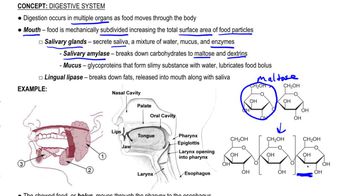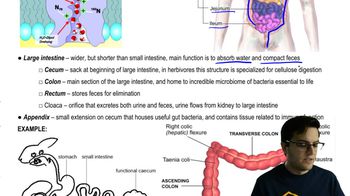Table of contents
- 1. Introduction to Biology2h 42m
- 2. Chemistry3h 40m
- 3. Water1h 26m
- 4. Biomolecules2h 23m
- 5. Cell Components2h 26m
- 6. The Membrane2h 31m
- 7. Energy and Metabolism2h 0m
- 8. Respiration2h 40m
- 9. Photosynthesis2h 49m
- 10. Cell Signaling59m
- 11. Cell Division2h 47m
- 12. Meiosis2h 0m
- 13. Mendelian Genetics4h 44m
- Introduction to Mendel's Experiments7m
- Genotype vs. Phenotype17m
- Punnett Squares13m
- Mendel's Experiments26m
- Mendel's Laws18m
- Monohybrid Crosses19m
- Test Crosses14m
- Dihybrid Crosses20m
- Punnett Square Probability26m
- Incomplete Dominance vs. Codominance20m
- Epistasis7m
- Non-Mendelian Genetics12m
- Pedigrees6m
- Autosomal Inheritance21m
- Sex-Linked Inheritance43m
- X-Inactivation9m
- 14. DNA Synthesis2h 27m
- 15. Gene Expression3h 20m
- 16. Regulation of Expression3h 31m
- Introduction to Regulation of Gene Expression13m
- Prokaryotic Gene Regulation via Operons27m
- The Lac Operon21m
- Glucose's Impact on Lac Operon25m
- The Trp Operon20m
- Review of the Lac Operon & Trp Operon11m
- Introduction to Eukaryotic Gene Regulation9m
- Eukaryotic Chromatin Modifications16m
- Eukaryotic Transcriptional Control22m
- Eukaryotic Post-Transcriptional Regulation28m
- Eukaryotic Post-Translational Regulation13m
- 17. Viruses37m
- 18. Biotechnology2h 58m
- 19. Genomics17m
- 20. Development1h 5m
- 21. Evolution3h 1m
- 22. Evolution of Populations3h 52m
- 23. Speciation1h 37m
- 24. History of Life on Earth2h 6m
- 25. Phylogeny2h 31m
- 26. Prokaryotes4h 59m
- 27. Protists1h 12m
- 28. Plants1h 22m
- 29. Fungi36m
- 30. Overview of Animals34m
- 31. Invertebrates1h 2m
- 32. Vertebrates50m
- 33. Plant Anatomy1h 3m
- 34. Vascular Plant Transport1h 2m
- 35. Soil37m
- 36. Plant Reproduction47m
- 37. Plant Sensation and Response1h 9m
- 38. Animal Form and Function1h 19m
- 39. Digestive System1h 10m
- 40. Circulatory System1h 57m
- 41. Immune System1h 12m
- 42. Osmoregulation and Excretion50m
- 43. Endocrine System1h 4m
- 44. Animal Reproduction1h 2m
- 45. Nervous System1h 55m
- 46. Sensory Systems46m
- 47. Muscle Systems23m
- 48. Ecology3h 11m
- Introduction to Ecology20m
- Biogeography14m
- Earth's Climate Patterns50m
- Introduction to Terrestrial Biomes10m
- Terrestrial Biomes: Near Equator13m
- Terrestrial Biomes: Temperate Regions10m
- Terrestrial Biomes: Northern Regions15m
- Introduction to Aquatic Biomes27m
- Freshwater Aquatic Biomes14m
- Marine Aquatic Biomes13m
- 49. Animal Behavior28m
- 50. Population Ecology3h 41m
- Introduction to Population Ecology28m
- Population Sampling Methods23m
- Life History12m
- Population Demography17m
- Factors Limiting Population Growth14m
- Introduction to Population Growth Models22m
- Linear Population Growth6m
- Exponential Population Growth29m
- Logistic Population Growth32m
- r/K Selection10m
- The Human Population22m
- 51. Community Ecology2h 46m
- Introduction to Community Ecology2m
- Introduction to Community Interactions9m
- Community Interactions: Competition (-/-)38m
- Community Interactions: Exploitation (+/-)23m
- Community Interactions: Mutualism (+/+) & Commensalism (+/0)9m
- Community Structure35m
- Community Dynamics26m
- Geographic Impact on Communities21m
- 52. Ecosystems2h 36m
- 53. Conservation Biology24m
39. Digestive System
Digestion
Problem 11a`
Textbook Question
Minnows are mainly carnivorous, eating insects and other small animals. However, herbivory has evolved independently in minnows several times.
What changes in digestive structure and function are associated with the evolution of herbivory?
Like cichlids, minnows use their pharyngeal jaws to process food. Suggest some possible structural differences between the teeth on the pharyngeal jaws of carnivorous and herbivorous minnows.
 Verified step by step guidance
Verified step by step guidance1
Begin by understanding the dietary needs of herbivorous versus carnivorous minnows. Herbivorous minnows require adaptations to digest plant material, which is often tougher and more fibrous than animal matter.
Consider the digestive tract length. Herbivorous fish typically have longer intestines to allow more time for the breakdown and absorption of plant materials, which are harder to digest than animal proteins.
Examine the role of pharyngeal jaws. These are specialized structures in the throat that help in processing food. In herbivorous minnows, the teeth on these jaws might be flatter and broader to grind plant material, whereas carnivorous minnows might have sharper teeth for tearing flesh.
Think about enzyme production. Herbivorous minnows may produce more cellulase or other enzymes that help break down cellulose, a major component of plant cell walls, whereas carnivorous minnows would produce enzymes that break down proteins and fats.
Consider the presence of symbiotic gut flora. Herbivorous minnows might have a more complex microbiome that aids in the digestion of plant material, similar to other herbivorous animals, whereas carnivorous minnows might have a simpler gut flora focused on protein digestion.
 Verified video answer for a similar problem:
Verified video answer for a similar problem:This video solution was recommended by our tutors as helpful for the problem above
Video duration:
30sPlay a video:
Was this helpful?
Key Concepts
Here are the essential concepts you must grasp in order to answer the question correctly.
Evolution of Herbivory
Herbivory in minnows involves adaptations that allow them to digest plant material efficiently. This evolutionary change often requires modifications in digestive enzymes and gut morphology to break down cellulose and other plant components. Understanding these adaptations helps explain how minnows can shift from a carnivorous to a herbivorous diet.
Recommended video:
Guided course

2) Exploitation (+/-): Herbivory
Pharyngeal Jaws
Pharyngeal jaws are specialized structures located in the throat of some fish, including minnows, used for processing food. These jaws can vary significantly between species, especially between carnivorous and herbivorous fish, with differences in tooth shape and arrangement to accommodate different diets. Herbivorous minnows may have flatter, broader teeth for grinding plant material.
Recommended video:
Guided course

Chordates
Digestive Structure and Function
The digestive system of herbivorous minnows is adapted to process plant material, which is typically harder to digest than animal matter. These adaptations may include a longer gut for increased digestion time and specialized enzymes to break down cellulose. Structural changes in the digestive tract are crucial for efficient nutrient absorption from a plant-based diet.
Recommended video:
Guided course

Digestion and Digestive Tracts
Related Videos
Related Practice















![Anatomy and Physiology of the Large Intestine [Colon]](https://img.youtube.com/vi/F4W2DLIKXww/mqdefault.jpg)




![IGCSE BIOLOGY REVISION - [Syllabus 7.5] Absorption](https://img.youtube.com/vi/TEOB94oBZN4/mqdefault.jpg)


























